When filling out the Arizona Operating Agreement form, many people overlook important details. One common mistake is not including all members of the LLC. It’s essential to list every member involved in the business. Omitting a member can lead to confusion and potential disputes later on.
Another frequent error is failing to specify the management structure. Some individuals assume that the default structure will apply, but it’s crucial to clarify whether the LLC will be managed by its members or by appointed managers. This decision impacts how the business operates and how decisions are made.
People often neglect to address profit and loss distribution. The Operating Agreement should outline how profits and losses will be shared among members. Without this information, misunderstandings can arise, leading to conflicts over financial matters.
Using vague language is also a mistake that can create problems. Clear and specific terms help prevent ambiguity. For instance, instead of saying “reasonable time,” specify what that means in the context of the agreement. This clarity helps all members understand their rights and obligations.
Another pitfall is not updating the Operating Agreement when changes occur. Life events, such as adding or removing members, should prompt a review of the agreement. Failing to make these updates can result in outdated provisions that no longer reflect the current structure of the LLC.
Some individuals forget to include provisions for dispute resolution. It’s wise to outline how conflicts will be handled, whether through mediation, arbitration, or another method. This foresight can save time and money if disagreements arise.
Additionally, many people overlook the importance of signatures. An Operating Agreement is not valid without the signatures of all members. Ensure that every member signs the document to confirm their agreement to the terms outlined.
People often underestimate the need for legal review. While it might seem straightforward, having a legal professional review the Operating Agreement can catch mistakes or omissions that could cause issues down the line. Investing in this step can provide peace of mind.
Finally, some individuals fail to keep copies of the signed agreement. Once completed, it’s important to distribute copies to all members and keep a record for the LLC’s files. This ensures that everyone has access to the agreement and can refer to it as needed.
